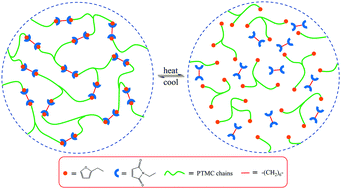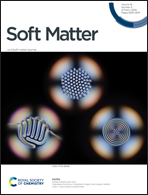Tuning the thermoreversible temperature domain of PTMC-based networks with thermosensitive links concentration
Abstract
In this work, thermoreversible poly(trimethylene carbonate) (PTMC) based networks with different crosslinking densities were obtained by Diels–Alder (DA) reaction between furan-functionalized PTMC precursors and a bismaleimide. Furan-grafted PTMC with various functionalities determined by 1H-NMR analyses were prepared from telechelic PTMC oligomer, glycerol, 4,4′-methylenebis(cyclohexyl isocyanate) (H12MDI) and furfuryl alcohol. The formation of network structures by DA reaction between furan and maleimide groups were proved by Fourier-transform infrared spectroscopy (FT-IR). Although both exo and endo DA adduct forms exist, the thermally more stable exo form dominates. The thermoreversibility of networks was evidenced by FT-IR, solubility, differential scanning calorimetry (DSC) and rheology experiments at different temperatures. By increasing furan functionality or node concentration, denser and stiffer networks could be formed with higher Young's modulus and true stress at break in tensile tests, as well as higher crossover temperature, which indicates a nominal transition from elastic behavior to viscous state. The disruption of networks was found to occur in high temperature ranges from 130 to 160 °C, depending on their crosslinking density.



 Please wait while we load your content...
Please wait while we load your content...